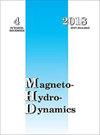低幅频外旋转磁场作用下铁磁流体速度剖面自旋黏度剪切系数估算
IF 0.3
4区 工程技术
Q4 MECHANICS
引用次数: 0
摘要
本文描述了一种数值策略,用于估计限制在圆柱形容器中并暴露于低振幅和低频率外部旋转磁场影响下的铁磁流体样品的自旋粘度剪切系数。据我们所知,目前还没有这种系数的实验测量结果。此外,报告的少数分析值在几个数量级上存在差异。首先,我们简要介绍了该系统的数学模型及其数值解。然后,给出了正问题和反问题的定义,作为估计该系数的方法的一部分。最后,我们使用模拟测量和两种全局优化算法来解决反问题。我们通过将高斯白噪声信号添加到铁流体力学数学模型的数值解中来生成这种类型的测量。为了验证目的,使用了10到40 dB范围内的几个噪声水平来增加场景的数量。结果表明,估计值与数学模型的数值解中使用的值之间非常一致。统计分析显示,正态分布取决于噪声水平。这种变化并没有影响结果,反而表明了所提出方法的有效性。此外,该策略是验证未来原位测量实验结果的计算工具。表7,图11,参考文献17。本文章由计算机程序翻译,如有差异,请以英文原文为准。
Shear coefficient of spin viscosity estimation through velocity profiles of a ferrofluid under the effect of an external rotating magnetic field of low amplitude and frequency
The present article describes a numerical strategy for the estimation of the shear coefficient of spin viscosity for a ferrofluid sample confined to a cylindrical container and exposed to the effect of an external rotating magnetic field with a low amplitude and frequency. As far as we know, there are no experimental measurements of such coefficient. Furthermore, the few analytical values reported differ in several orders of magnitude. First, we describe briefly the mathematical model of the system and its numerical solution. Then, the definition of the direct and inverse problems is given as a part of the methodology for estimating such coefficient. Finally, we solve the inverse problem using simulated measurements and two global optimization algorithms. We generate this type of measurements by adding white Gaussian noise signals to the numerical solution of the ferrohydrodynamic mathematical model. Several noise levels in the range of 10 to 40 dB were used to increase the number of scenarios for validation purpose. Results showed an excellent agreement between the estimated values and those used in the numerical solution of the mathematical model. A statistical analysis revealed a normal distribution that was dependent on the noise level. This variation did not affect the results, but showed instead the validity of the proposed method. Additionally, this strategy stands as a computational tool for validating experimental results of the future in situ measurements. Tables 7, Figs 11, Refs 17.
求助全文
通过发布文献求助,成功后即可免费获取论文全文。
去求助
来源期刊

Magnetohydrodynamics
物理-力学
CiteScore
1.20
自引率
14.30%
发文量
37
审稿时长
6-12 weeks
期刊介绍:
Information not localized
 求助内容:
求助内容: 应助结果提醒方式:
应助结果提醒方式:


